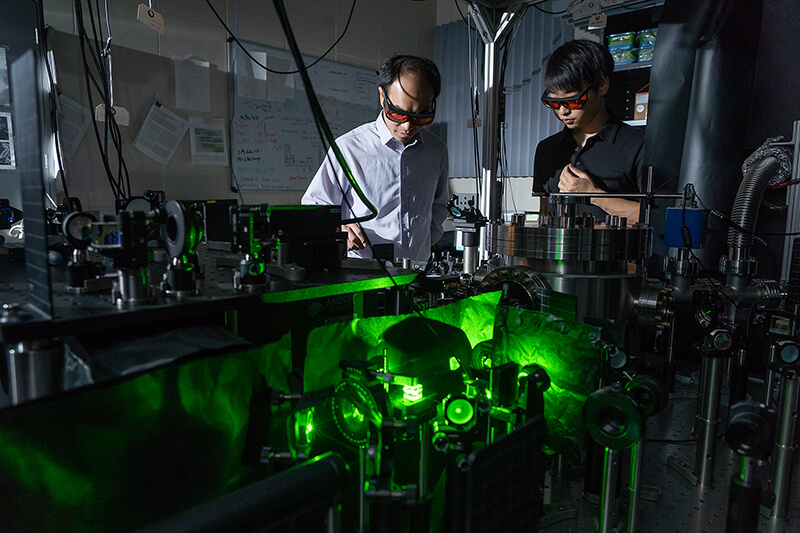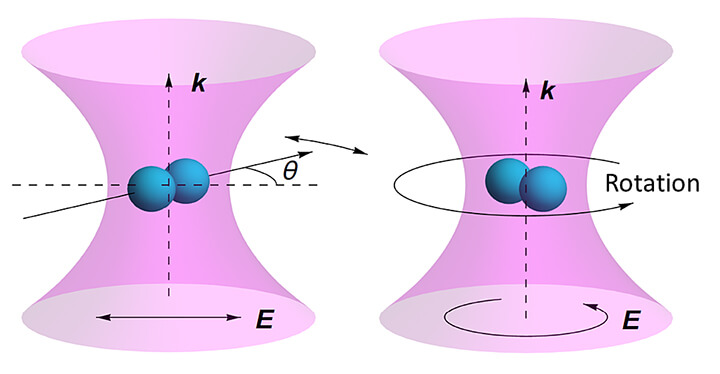July 20, 2018
World’s fastest man-made spinning object could help study quantum mechanics

Tongcang Li and Jonghoon Ahn have levitated a nanoparticle in vacuum and driven it to rotate at high speed, which they hope will help them study the properties of vacuum and quantum mechanics. (Purdue University photo/Vincent Walter)
 A nanodumbbell levitated by an optical tweezer in vacuum can vibrate or spin, depending on the polarization of the incoming laser. (Purdue University photo/Tongcang Li)
Download image
A nanodumbbell levitated by an optical tweezer in vacuum can vibrate or spin, depending on the polarization of the incoming laser. (Purdue University photo/Tongcang Li)
Download image
WEST LAFAYETTE, Ind. — Researchers have created the fastest man-made rotor in the world, which they believe will help them study quantum mechanics.
At more than 60 billion revolutions per minute, this machine is more than 100,000 times faster than a high-speed dental drill. The findings were published in the journal Physical Review Letters.
“This study has many applications, including material science,” said Tongcang Li, an assistant professor of physics and astronomy, and electrical and computer engineering, at Purdue University. “We can study the extreme conditions different materials can survive in.”
Li’s team synthesized a tiny dumbbell from silica and levitated it in high vacuum using a laser. The laser can work in a straight line or in a circle – when it’s linear, the dumbbell vibrates, and when it’s circular, the dumbbell spins.
A spinning dumbbell functions as a rotor, and a vibrating dumbbell functions like an instrument for measuring tiny forces and torques, known as a torsion balance. These devices were used to discover things like the gravitational constant and density of Earth, but Li hopes that as they become more advanced, they’ll be able to study things like quantum mechanics and the properties of vacuum. Watch a video to see how it happens here.
“People say that there is nothing in vacuum, but in physics, we know it’s not really empty,” Li said. “There are a lot of virtual particles which may stay for a short time and then disappear. We want to figure out what’s really going on there, and that’s why we want to make the most sensitive torsion balance.”
By observing this tiny dumbbell spin faster than anything before it, Li’s team may also be able to learn things about vacuum friction and gravity. Understanding these mechanisms is an essential goal for the modern generation of physics, Li said.
Researchers from Purdue, Peking University, Tsinghua University, and the Collaborative Innovation Center of Quantum Matter in Beijing also contributed to this work. The first author of this work is Jonghoon Ahn, a graduate student in Li’s research group. Li’s research was funded by the National Science Foundation and Office of Naval Research.
A YouTube video is available at https://youtu.be/dyn5MoYPnmw, and other multimedia can be found in a Google Drive folder at https://goo.gl/euj7BE. The video was prepared by Erin Easterling, digital producer for the Purdue College of Engineering, 765-496-3388, easterling@purdue.edu.
Writer: Kayla Zacharias, 765-494-9318, kzachar@purdue.edu
Source: Tongcang Li, 765-496-0072, tcli@purdue.edu
Note to journalists: For a copy of the paper, please contact Kayla Zacharias, Purdue News Service, kzachar@purdue.edu
ABSTRACT
Optically Levitated Nanodumbbell Torsion Balance and GHz Nanomechanical Rotor
Jonghoon Ahn, Zhujing Xu, Jaehoon Bang, Yu-Aao Deng, Thai M. Hoang, Qinkai Han, Ren-Min Ma, Tongcang Li
Levitated optomechanics has great potential in precision measurements, thermodynamics, macroscopic quantum mechanics, and quantum sensing. Here we synthesize and optically levitate silica nanodumbbells in high vacuum. With a linearly polarized laser, we observe the torsional vibration of an optically levitated nanodumbbell. This levitated nanodumbbell torsion balance is a novel analog of the Cavendish torsion balance, and provides rare opportunities to observe the Casimir torque and probe the quantum nature of gravity as proposed recently. With a circularly polarized laser, we drive a 170-nm-diameter nanodumbbell to rotate beyond 1 GHz, which is the fastest nanomechanical rotor realized to date. Smaller silica nanodumbbells can sustain higher rotation frequencies. Such ultrafast rotation may be used to study material properties and probe vacuum friction.

